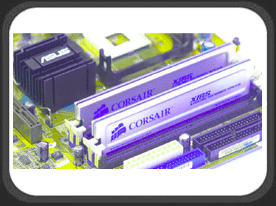| Memory 'Buy' The Numbers - Page 3 of 4 |
DDR:
Next we move in to the DDR numbers. Here again is where you need to not only break out the caculators, but also understand that marketing people got involved (OY VEY). The slowest DDR is called either DDR200 or PC1600. Ok, hold on... before that glazed over confused look hits you, let’s see if we can explain the reasoning for this numbering system.

Example of DDR Memory
When DDR first appeared on the market, the system bus speeds on a computer hadn’t changed. They were still running at 100MHz & 133MHz. Now because this is DDR, or DOUBLE Data Rate, the number DDR200 made perfect sense (2 X 100 = 200). But what about this PC1600?? This is where the marketing people got involved. At the time RAMBUS was out and showing some impressive numbers. RAMBUS had spec numbers such as PC800 and PC1066, and there was no way DDR was going to be handicapped by smaller numbers. So here is how the PC numbers work on DDR. The numbers are achieved by using the maximum bandwidth (in MegaBytes per second) the memory was able to achieve. For those interested in the formula, it is: {Bus Speed in Mhz} x 2 (DDR) x 64 (the size of the bus in bits) / 8 (8 bits = 1 byte). So let’s see how this works
• PC1600 = 100 x 2 = 200 x 64 = 12800 / 8 = 1600
Now isn’t that simple and straight forward? Yeah, I don’t think so either. But to clear up the confusion on the rest of DDR, let’s take a look at it:
• PC2100 = 133 x 2 x 64 / 8 = 2100 or DDR266
• PC2400 = 150 x 2 x 64 / 8 = 2400 or DDR300
• PC2700 = 166 x 2 x 64 / 8 = 2664 or DDR333
• PC3000 = 183 x 2 x 64 / 8 = 2928 or DDR366
• PC3200 = 200 x 2 x 64 / 8 = 3200 or DDR400
• PC4000 = 250 x 2 x 64 / 8 = 4000 or DDR500
• It just keeps going…..
Again, I’m sure you are looking at some of those numbers and going… “HUH? Those numbers don’t make sense. First off, there is no such things as a bus speed of 150 MHz, 183 MHz, or 250 MHz.” You would be correct. Those pieces are just like the PC150 & PC166 SDRAM. They are for overclocking of your Front Side Bus (FSB). They are not standard, nor are they going to perform consistently at the rated speeds from different manufactures. So if you aren’t overclocking, don’t bother spending the money.
“Ok, so what about those rounded numbers? I thought you said that engineers did this. And engineers DON’T round!” True, but I also said that marketing people were involved... and we KNOW they round. (Surprised they didn’t actually round up to the nearest million).
There you go… the story of DDR.
Dual Channel DDR:
I have seen some confusion on exactly what “Dual Channel DDR” is. Well, it’s DDR. Simple as that. Dual Channel has nothing to do with the RAM itself, it has to do with the memory controller. By “linking” two RAM modules together, chipset manufacturers are in theory getting double the throughput of a single channel set up. In theory a Single DDR module gets 3.2GB of memory bandwidth, while Dual Channel DDR gets 6.4GB of memory bandwidth. Unfortunately theory and reality are seldom the same, and it holds true with this. While you do get better performance, you will not see double the speed in the real world. If you have a motherboard that supports Dual Channel DDR, it is worth the effort to buy 2 of the exact same RAM modules instead of 1 bigger one, or two different, unmatched kinds.

Example of Dual Channel DDR Memory
Image Source: Corsair
Please read on to the next page for more... Next
Page 1 | Page 2 | Page 3 | Page 4 | Home | Forum | Review Index
|
|
|
|